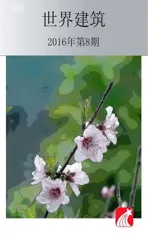克雷泰伊大教堂扩建,克雷泰伊,法国
2016-10-20张裕翔
克雷泰伊大教堂扩建,克雷泰伊,法国
建筑设计:AS建筑工作室
Architects: Architecture-Studio
2009年,在Santier主教的倡议和红衣主教工程协会的支持下,克雷泰伊教区管理协会为克雷泰伊圣母院教堂扩建项目选择了一个富有野心的方案。该教堂原有建筑部分由罗马大奖获得者夏尔-古斯塔夫-施托斯科普夫(Charles-Gustave Stoskopf)设计,是一幢十分符合1970年代“共融式神学”精神的建筑。现在,它也被认为是克雷泰伊城当代遗产的一部分。
项目的主要目的是为了将原教堂的使用面积扩大一倍,并让它在城市中获得更强的识别性。
包括内部装修在内,该项目对教堂进行了较大程度的改造,使之在象征意义和教化效用方面都获得了更持久的生命力。这座改造后的教堂矗立于一片多文化融合的城市区域中:地块内包括5座天主教堂、10座犹太教堂、一座清真寺、一座新教教堂、4座福音派教堂、一座佛寺和一座巴哈教的集会中心。
该设计在两种不同却具有相容性的建筑风格之间建立了对话。指向天空的穹顶源于原建筑的形式。具有人性化设计的入口处轮廓与新项目宏大的规模相结合,从教堂中殿扩展开的两个木质覆盖的球状外壳,犹如位于祭坛上方正在祈祷的双手。
改造后的空间可以容纳大型的集会。设计改变了原有圣坛的形状,并将祷告长凳按照一个宽阔的圆弧形布置在了大厅中。在阳光下,两片壳形结构中间的染色玻璃将彩色的光斑投射在圣坛上。天黑后,教堂的内部被点亮,这些发光的玻璃则代表着一个活跃的基督教社区的存在。
钟楼与主体建筑脱离开来,位于教堂前广场的一角,用狭长的轮廓标识出了教堂的主入口,其楼身上有3个开洞,洞里分别放置了3个老钟楼内的钟摆。这座钟楼使教堂保有了城市建筑的尺度感,并成为了在大型住宅楼群旁树立起的城市标志物。大教堂前的原有树木被移走,打开了广场上的视野。城市建设部门在教堂另一侧设立了一座新广场,不仅为市民生活提供了便利,也促进了教会生活的扩展。
另一个重要动机——一条轴线与原有轴线垂直,穿过教堂内部。这条轴线是天顶的彩绘玻璃,阳光透过玻璃形成的五彩光线环绕空间。同时,这里还有一条朝光源上升的流线:一条从圣坛通往进入画廊的两个台阶入口的流线——该线路在染色玻璃的弯曲下被延长了一些。在圣坛正上方落下一道光线,作为Udo Zembok壮观的染色玻璃作品的构图中心。这样,这个十字形结构就从3个维度上定义了这个空间:首先,这是一个随昼夜和季节变化的空间,教堂的方向与方位基点相差无几,并通过精心设计染色玻璃的位置而获得全天日照。
建筑的基本概念是两个壳形空间的交合,它强调并升华了两个壳体之间重叠的边界式空间。
这个被设计为一个玻璃拱的空间是本项目的重头戏。半圆拱在空间中自东向西展开。作为空间内的唯一自然光源,玻璃拱延伸到空间的最高点处,垂直环绕在圣坛之上。作为结构,木质截面肋在每隔相同的距离之间将连续的玻璃条带打断。
对建筑形体的艺术回应依赖于入射光的奇妙变幻,也就是说,在进入神圣空间的时刻,光线自身已经被神圣化了。光线本身是无形的,我们只能通过它们在物体上的反射或有色过滤才能察觉到光的存在。因此,这一概念的简约性和组成元素之间的微妙关系为观者提供了不同层面上的想象空间。不同的理解可以是简单的对于彩色光线以及它们对内部空间产生的效果的喜爱,而更深层次地,也可能是对于光的三原色、它们的空间角色及其与“三位一体”的象征性关系的联想。□(张裕翔 译)

1 外景/Exterior view

2 鸟瞰/Aerial View
2

3 内景/Interior view
In 2009,on the initiative of Bishop Santier,the diocesan association of Créteil,supported by the Chantiers du Cardinal,opted for an ambitious project to expand the cathedral of Notre- Dame de Créteil.Conceived by Charles-Gustave Stoskopf,owner of the Prix de Rome,this building is typical of the 1970s when "the theology of blending-in" prevailed at the time.It is part of the contemporary heritage of the City of Créteil.
The commission was to double the capacity of the cathedral and to enhance its visibility towards the city.
More than a renovation,this project involves a major redevelopment of the cathedral,giving it a new architectural lease on life from a symbolic and pastoral point of view.The new cathedral is anchored in a multicultural city,which includes five Catholic churches,ten synagogues,a mosque,a Protestant church,four Evangelical churches,a Buddhist temple and a Bahai assembly.
A dialogue between two different architectural styles,yet consistent,is established.The dome pointing skywards is based on the footprint of the original cathedral.The silhouette of the entrance,on a human scale,is now joined with the monumental proportions of the new project,focusing on the nave of the cathedral that extends from two spherical wood-clad hulls,like two hands joined in prayer that meet above the altar.
Large gatherings can be held in this new space.The existing sanctuary has been remodeled and the benches are placed in a broad semicircle.In daylight,the stained-glass window located at the junction of the two hulls shed a colored light onto the sanctuary,while at night,illuminated from inside,they become the symbol of a living Christian community.
The steeple,detached from the building on the corner of the forecourt,marks the cathedral entrance with its slender silhouette,punctuated by three bells from the old campanile.It restores the building urban scale and become a sign in the city beside the large residential buildings of the neighborhood.The view onto the cathedral forecourt is freed by opening the curtain of trees.The new square,built by the city on the opposite side,is an amenity for local residents,and an extension of parish life.
Another movement,another axis,perpendicular to the previous one,crosses the space of the cathedral.This axis is the one of the stained glass,whose colored light encircles the space from its zenith.There is also an ascending path that rises to the source of this light: a movement from the altar to the two accesses steps to the gallery,which is extended by the curve stained glass.A path of light hangs vertically from the altar,climax of the composition of the Udo Zembok's magnificent stained glass.The cross thus signs this space in three Dimensions,a space that vibrates to the rhythm of day and seasons,the orientation of the cathedral on the points of the compass-give or take a few degrees-and the positioning of the stained glass at the head of the southern hull,allowing the building to receive sunlight throughout the day.
The architectural concept of two intersecting shellshaped spatial forms celebrate a space which unfolds like a border along the interface of the two volumes.
This space,designed as a glass arch,is the feld of play for this commission.Spatially,the semicircular arc opens up from east to west.As the only source of natural light the arc culminates at the zenith,vertically centered over the altar.At regular intervals,cross section wooden ribs interrupt the continuous ribbon of glass.
The artistic response to the given architectural shape is based on the idea that the incident sunlight artistically metamorphoses and thus should enter equally "sublimated" into the sacred space.Paradoxically,however,light itself is invisible,because it is only perceptible to our senses when it reflects on material or flows through filters.The simplicity of the concept and composition opens up a range of different levels of understanding for the observant visitor.The spectrum ranges from our delight in chromatic filtered colors and their effects on the interior architecture of the cathedral,to the concept of the three primary colors of light,their spatial positions and the symbolism of the Holy Trinity.□

4 首层平面/Floor 0 plan 1-主入口/Main Entrance 2-前廊/Narthex 3-唱诗班/Choir 4-中殿/Nave 5-小礼拜堂/Chapel 6-会议厅/Conference room 7-礼堂/Auditorium 8-展览空间/Exhibition space 9-画廊/Gallery 10-办公/Ofces 11-咖啡厅/Café12-次入口/Secondary entrance

项目信息/Credits and Data
项目信息/Credits and Data
承包机构/Contracting Authority: Diocesan Association of Créteil,Association "Chemin des arts" in Val-de-Marne
授权承包机构/Delegated Contracting Authority: Les Chantiers du Cardinal
协助承包机构/Assisting Contracting Authority: TEWAKO
结构和表皮/Structure and Wrap: T/E/S/S
动线/Fluids: Louis Choulet
声环境设计/Acoustics: AVA
光环境设计/Light Designer: 8'18"
理财/Economy: Éco-Cités
木材顾问/Wood Specialist: Sylva Conseil
染色玻璃设计/Stained-Glass Window Conception: Pascale and Udo Zembok
染色玻璃艺术指导/Stained-Glass Window Art Direction: Udo Zembok
BET玻璃/BET Glass: Hoffmann GTD
窗加工/Window's Production: Glasmalerei Peters Studio
改造表面积/Surface of the Deployment: 1400m2
教堂高度/Height of the Cathedral: 2240m
钟塔高度/Height of the Bell Tower-Signal: 4450m
南侧壳体梁/Beam South Shell in the Axis: 1957m for 63 bows北侧壳体梁/Beam North Shell in the Axis: 1995m for 64 bows
弓形层压梁截面/Section of Stuck-Laminated Bows: 160×750 mm弓形梁之间的轴/Axis between the Bows: 560mm
壳体总表面积/Surface of the Shells: 1600m2
弓形层压梁总体积/Laminated Wood Stuck Bows in Spruce: 350m3
金属框材/Metallic Frame: 40t
木条线性长度/Wooden Strips of Douglas Linear: 25,000m
总造价/Total Cost: €9,000,000(税前/Before Tax)
人工费用/Cost of Work: €575,000,000(税前/Before Tax)建成时间/Completion: 2015
效果图/Synthesized Images: Architecture-Studio,T/E/S/S
摄影/Photos: Luc Boegly,Yves Mernier,Udo Zembok
The Expansion of the Cathedral of Créteil,Créteil,France,2015

6 外景/Exterior view


7.8 拱顶细部/Details of the arches


9 结构及覆层/Structure and cladding

10 内景/Interior view
